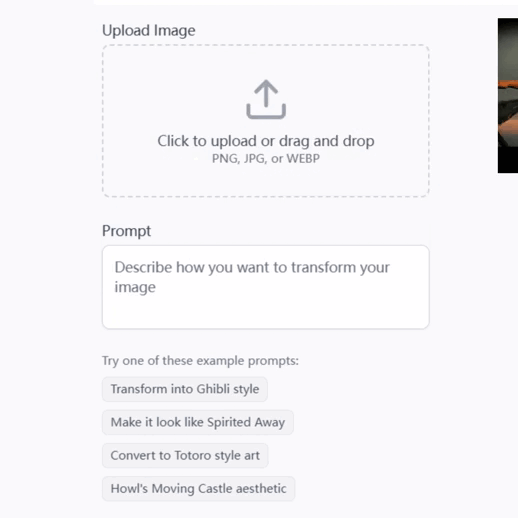
Shadcn/UI & Tailwind To SwiftUI - TSX to SwiftUI Code Conversion

こんにちは、TypeScript JSXをSwiftUIに変換しましょう。
Transform web UI to native iOS seamlessly.
Translate the following TypeScript JSX component using Tailwind CSS into a SwiftUI view:
How would you convert a Shadcn UI button in TypeScript JSX to SwiftUI?
What are the best practices for translating a Tailwind CSS layout from TSX to SwiftUI?
Explain the process of converting a responsive TSX design into a SwiftUI interface.
Get Embed Code
Overview of Shadcn/UI & Tailwind To SwiftUI
The Shadcn/UI & Tailwind To SwiftUI GPT specializes in translating user interface components and styles from a TypeScript JSX (TSX) environment using Shadcn UI components and Tailwind CSS into SwiftUI code. This process involves mapping the responsive and utility-first design approach of Tailwind CSS along with the component structure of Shadcn UI to the declarative syntax and design patterns of SwiftUI. The primary purpose of this GPT is to assist developers in transitioning web-based projects or components to iOS and macOS applications by converting codebases, ensuring that the visual integrity and functionality are preserved across platforms. Example scenario: A developer has a web application built with React and Tailwind CSS and wishes to create a native mobile version using SwiftUI. The GPT helps translate UI components like buttons, modals, and forms directly into SwiftUI, maintaining responsiveness and styling. Powered by ChatGPT-4o。

Core Functions and Use Cases
Code Translation
Example
Translating a Button component from TSX using Shadcn UI to SwiftUI. In TSX: <Button color='primary' size='lg'>Click Me</Button> translates to SwiftUI: Button('Click Me').foregroundColor(.primary).font(.system(size: 16))
Scenario
Useful in scenarios where a developer needs to quickly port a feature-rich web interface to a mobile app, ensuring the UI components align with iOS design standards.
Style Mapping
Example
Mapping Tailwind CSS utility classes to SwiftUI modifiers. TSX class='text-lg bg-red-500 hover:bg-red-700' translates to SwiftUI modifiers like .font(.system(size: 18)).background(Color.red500).hoverEffect(.highlight).
Scenario
Applicable when adapting a web design's responsiveness and theme to mobile devices, preserving visual consistency and user experience.
Component Structuring
Example
Converting complex UI structures such as navigation bars or forms. A TSX NavBar might be converted into a SwiftUI NavigationView with corresponding items and links.
Scenario
Particularly helpful when developers are building a SwiftUI app that needs a structured, navigable UI that was originally designed for web.
Target User Groups
Web Developers
Developers familiar with TSX and Tailwind who are looking to expand into mobile app development with SwiftUI without starting from scratch. They benefit by leveraging existing codebases and design paradigms.
UI/UX Designers
Designers who aim to ensure the fidelity of their designs across platforms will find this GPT useful for understanding how web-based design elements translate into mobile contexts.
Project Managers
Managers overseeing cross-platform software projects can use this service to streamline development processes, ensuring quick adaptation of web components for iOS and macOS applications.

Guidelines for Using Shadcn/UI & Tailwind To SwiftUI
Step 1
Start your journey by visiting yeschat.ai to initiate a free trial without any requirement for login, and there's no necessity for ChatGPT Plus.
Step 2
Familiarize yourself with the basic concepts of SwiftUI, Tailwind CSS, and Shadcn/UI to effectively translate your existing web designs into native iOS views.
Step 3
Explore the syntax differences between JSX used in Shadcn/UI and the Swift language used in SwiftUI. Pay special attention to layout controls, style expressions, and interactivity.
Step 4
Utilize the provided code translation examples to practice converting typical Shadcn/UI components and Tailwind CSS utility classes into SwiftUI equivalents.
Step 5
Test your translated SwiftUI views on various iOS devices to ensure responsive and functional design, making use of Xcode’s preview and simulator tools.
Try other advanced and practical GPTs
Hang SEO
Empower Your Content with AI

Hang Pan Harmony
Master the Hang Pan with AI-powered guidance.

🤩Hang Bo High EQ Dialogue | 黄渤高情商回答
Engage with AI-powered Humor and Insight

Korean Tutor
Master Korean with AI-Powered Precision

Hang out Harley
Your Empathetic AI Companion

Nature Medicine Style Expert
Enhancing Scientific Communication with AI

Mockup Maker
AI-powered UI Component Builder

shadcn/ui
Elevate your web interfaces with AI

NovelGPT
Bring Stories to Life with AI

NovelGPT
Craft Your Story with AI Expertise

NovelGPT
Craft Your Story, Powered by AI

moodread
Align your read to your mood

Frequently Asked Questions About Shadcn/UI & Tailwind To SwiftUI
What are the main challenges when converting Shadcn/UI and Tailwind CSS to SwiftUI?
The primary challenges include adapting Tailwind's utility-first CSS classes into SwiftUI's declarative syntax, and mapping Shadcn/UI's rich component library to SwiftUI’s more limited set of native components.
Can I directly map Tailwind CSS classes to SwiftUI properties?
Direct mapping is not always possible due to conceptual differences. Instead, you'll need to create equivalent style modifiers in SwiftUI that replicate the visual design defined by Tailwind’s classes.
How does Shadcn/UI’s component model compare to SwiftUI’s views?
Shadcn/UI components are typically more granular, with many options for configuration, whereas SwiftUI views are broader and often require more manual composition to achieve similar layouts.
Is there a tool or plugin to automate the conversion from Shadcn/UI & Tailwind CSS to SwiftUI?
Currently, there is no fully automated tool for this conversion. The process involves manual coding and adjustments to ensure that the UI components render accurately in SwiftUI.
What are some best practices for ensuring that my SwiftUI interfaces perform well on all Apple devices?
Best practices include using VStack and HStack for layout instead of relying solely on spacers, employing conditional modifiers for different device sizes, and frequent testing with Xcode’s device-specific preview features.






